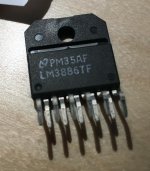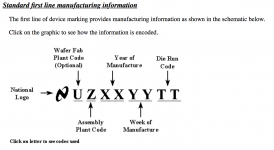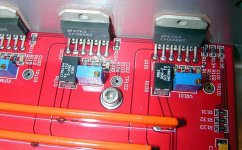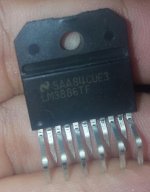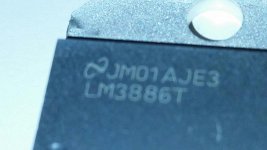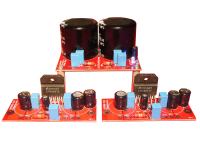Assuming that this LM3886 is a test reject, it is indeed a stolen part. It's not like TI or Analog Devices, any other reputable semiconductor company has a B-stock / irregulars bin that they sell off at discount.
Some time ago I opened up an LM3886 that I ESD-damaged. The die is large. The dies will be clearly marked with the company's logo and some sort of die ID -- in this case "LM3886". Generally counterfeit parts fall into two categories -- 'genuine' die that somehow escaped from the manufacturing process -- usually the final in-package test, though sometimes earlier in the process, or, some other die in a device that's remarked to make you think that it's what you want.
Some time ago I opened up an LM3886 that I ESD-damaged. The die is large. The dies will be clearly marked with the company's logo and some sort of die ID -- in this case "LM3886". Generally counterfeit parts fall into two categories -- 'genuine' die that somehow escaped from the manufacturing process -- usually the final in-package test, though sometimes earlier in the process, or, some other die in a device that's remarked to make you think that it's what you want.
I think we could call fake parts fake. Fake parts have made it into the distribution path before. It doesn't take much reading of the various trade magazines to realize the magnitude of the problem.
The markings on the part shown above don't match National's marking scheme. National hasn't used silk screening of the part numbers for well over a decade. If you did indeed buy that from Farnell, I suggest you let Farnell know about it so they can trace it back to the source.
Tom
The markings on the part shown above don't match National's marking scheme. National hasn't used silk screening of the part numbers for well over a decade. If you did indeed buy that from Farnell, I suggest you let Farnell know about it so they can trace it back to the source.
Tom
Last edited:
Except the chip marking format is as shown in attached screen shot from ChipDocs: National Semiconductor
I linked to this in Post #1.
Tom
I linked to this in Post #1.
Tom
Attachments
Then all the (pad) printed lm3886 chips are fakes. Some have only two numbers and two letters as used in the JF model 10. Most have PM or JM followed by two numbers and two letters.
I guess they are using UZXYTT.
From the NS doc:
Date of manufacture codes
Marks indicating the date of manufacture occurs in four, three, or two digit versions. The date code marked represents a six week period in which the device was assembled.
I guess they are using UZXYTT.
From the NS doc:
Date of manufacture codes
Marks indicating the date of manufacture occurs in four, three, or two digit versions. The date code marked represents a six week period in which the device was assembled.
Last edited:
Read more closely. Two-digit date codes are only used on parts which are too small to get a longer marking. In no way can you consider this a physically small part.
I could not find one image on internet that doesn't have the notation UZXYTT or XYTT for the printed LM3886 or LM4780. Are they all fakes? Obviously NS consider the chips too small.
Attachments
Last edited:
Actually, that whole fake chip story may be a red herring, so I am still waiting for Tom to test the xy PCB with a known good one. It is well possible that the slightly inferior performance of the xy PCB at higher power is due to some layout issues, or perhaps the undersized decoupling caps.
The leading P in PM35AF (Post #222) indicates that the chip is manufactured in China. National doesn't/didn't have a fab in China.
Fresh from Deep Throat (my source in TI):
ICs produced after the TI acquisition of National Semiconductor in 2011 are marked according to the TI marking standard: National Semiconductor logo followed by YMLLLPG3, where the "P" indicates the A/T (Melaka plant A), and "G3" is the level of environmental friendliness of the package. The insolated package will be the same except there will be an "E3" rather than a "G3" as its environmental friendliness level is different.
I've attached a picture of a known genuine National Semiconductor LM3886T of ~2010 vintage. Pardon the image quality. The marking is done with laser - not silk screen.
For those who wish to mince words can use "counterfeit" rather than "fake" if that makes them feel better.
Tom
Fresh from Deep Throat (my source in TI):
ICs produced after the TI acquisition of National Semiconductor in 2011 are marked according to the TI marking standard: National Semiconductor logo followed by YMLLLPG3, where the "P" indicates the A/T (Melaka plant A), and "G3" is the level of environmental friendliness of the package. The insolated package will be the same except there will be an "E3" rather than a "G3" as its environmental friendliness level is different.
I've attached a picture of a known genuine National Semiconductor LM3886T of ~2010 vintage. Pardon the image quality. The marking is done with laser - not silk screen.
For those who wish to mince words can use "counterfeit" rather than "fake" if that makes them feel better.
Tom
Attachments
Actually, that whole fake chip story may be a red herring, so I am still waiting for Tom to test the xy PCB with a known good one. It is well possible that the slightly inferior performance of the xy PCB at higher power is due to some layout issues, or perhaps the undersized decoupling caps.
I think you are correct. I first believed that the IC could have been fake and that the poor results at higher power output where possibly/partly caused by an over active limiting circuit, which would be a difficult part of the NS circuit to replicate. Now I just think that these chips are old stock and were made before 2006.
Last edited:
You can think what you want, but the documented fact is that the various ink-marked units shown are not marked consistent with any National Semi or TI symbolization scheme.
So, Tom's source indicates that the die inside appears to be a genuine LM3886 die. That doesn't mean that it is 'top drawer', though at times people are known to remark 'good' material in an effort to cover up illegally-obtained material -- the IC equivalent of money laundering, I suppose. Still, if of unknown provenance, one can't be sure it is in spec.
So, Tom's source indicates that the die inside appears to be a genuine LM3886 die. That doesn't mean that it is 'top drawer', though at times people are known to remark 'good' material in an effort to cover up illegally-obtained material -- the IC equivalent of money laundering, I suppose. Still, if of unknown provenance, one can't be sure it is in spec.
In ti forums ti says: All authentication requests need to be routed to ti-counterfeit@list.ti.com. So maybe they can answer.
https://e2e.ti.com/support/amplifiers/audio_amplifiers/f/6/tags/Counterfeit
Surly two american companies, ti/ebay should be able to shut down these small chinese counterfeiters.
For the record: In a professional capacity I would never use these counterfeited chips, and of cource source them from a reliable channel.
But this is DIY🙂 And a normal ebay customer can't be responsible to choose an non crooked service privider.
https://e2e.ti.com/support/amplifiers/audio_amplifiers/f/6/tags/Counterfeit
Surly two american companies, ti/ebay should be able to shut down these small chinese counterfeiters.
For the record: In a professional capacity I would never use these counterfeited chips, and of cource source them from a reliable channel.
But this is DIY🙂 And a normal ebay customer can't be responsible to choose an non crooked service privider.
Of course not a big problem.
Guess ti don't care.
So buying sub par components to get almost on par performance at 20 to 30 % of the price is a no brainer to me, as long as i don't get sued if it fails or make me responsible for the worlds organized crime.
Guess ti don't care.
So buying sub par components to get almost on par performance at 20 to 30 % of the price is a no brainer to me, as long as i don't get sued if it fails or make me responsible for the worlds organized crime.
And even US ebay shop has the PM35AF:
LM3886TF 68W Low Noise Audio Power Amplifier Lot of 2 LM3886TF | eBay
So you can't go by price to garantee autencity
LM3886TF 68W Low Noise Audio Power Amplifier Lot of 2 LM3886TF | eBay
So you can't go by price to garantee autencity
1 Wafer Fab and Assembly Plant Codes
Table 1 lists single-letter codes for National Semiconductor's wafer fabrication plants. Letters that are not
in this list indicate wafer fabrication at one of National Semiconductor's approved sub-contractors.
Table 1. Wafer Fab Plant Code
Code Fab Location
E Arlington, TX
J Greenock, UK
R Santa Clara, CA
V South Portland, ME
X Arlington, TX
0 Multiple Fab Origin
1 USA (Sub-con)
2 Taiwan (Sub-con)
3 USA (Sub-con)
8 Singapore (Sub-con)
M USA (Sub-con)
N Israel (Sub-con)
P China (Sub-con)
W Japan (Sub-con)
Z USA (Sub-con)
Table 1 lists single-letter codes for National Semiconductor's wafer fabrication plants. Letters that are not
in this list indicate wafer fabrication at one of National Semiconductor's approved sub-contractors.
Table 1. Wafer Fab Plant Code
Code Fab Location
E Arlington, TX
J Greenock, UK
R Santa Clara, CA
V South Portland, ME
X Arlington, TX
0 Multiple Fab Origin
1 USA (Sub-con)
2 Taiwan (Sub-con)
3 USA (Sub-con)
8 Singapore (Sub-con)
M USA (Sub-con)
N Israel (Sub-con)
P China (Sub-con)
W Japan (Sub-con)
Z USA (Sub-con)
Of course not a big problem.
Guess ti don't care.
So buying sub par components to get almost on par performance at 20 to 30 % of the price is a no brainer to me, as long as i don't get sued if it fails or make me responsible for the worlds organized crime.
You are not building your amplifier for 20-30% of the price. You are saving a few dollars on a $x00 build. Also is Toms fake LM3886 representative of all fakes, or is it better or worse than many of the others? For the few dollars you save you really wouldn't have a clue what you are buying. If the chip fails you could destroy the bass driver in your speakers.
A few years back I unknowingly bought some fake LM3886s, one was DOA and the other clipped very early on negative peaks A total waste of time and money.
- Home
- Amplifiers
- Chip Amps
- XY LM3886 Kit Review & Measurements
